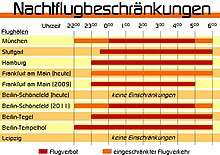Night flying restrictions
Night flying restrictions are any regulations or legislation imposed by a governing body to limit the ground-perceived exposure to aircraft noise during the night hours, when the majority of residents are trying to sleep. Such regulations may include restrictions to available flight paths, or prohibitions against takeoffs, or prohibitions against takeoffs and landings, or prohibitions against ground operations (engine runups or taxiing).
European airports

Night flying restrictions, commonly known as curfews, are common at airports in Europe.
London airports
The night restrictions for Heathrow, Gatwick and Stansted define a night period, 2300–0700 hours, and a night quota period, 2330–0600 hours. During the night period, the noisiest types of aircraft (classified as QC/4, QC/8 or QC/16 under the Quota Count system) may not be scheduled to land or to take off (other than in the most exceptional circumstances, such as an emergency landing). In addition, during the night quota period movements by most other types of aircraft (including the new QC/0.25 category) will be restricted by a movements limit and a noise quota, which are set for each season.[1]
Germany
Most airports in Germany have restrictions and curfews during the night. Frankfurt International Airport, for example has a total ban on scheduled aircraft movements between 2300 and 0500 hours, and during the morning and evening periods (2200-2300 and 0500-0600) a limited number of flights are allowed, providing they comply with ICAO Chapter 4 noise regulations. Further restrictions apply to noisier aircraft. [2]
References
- DfT statement
- AIP Germany. Version 06/16 (2016, May 26). AD 2 EDDF 1-16 (2.20.2.1.4).